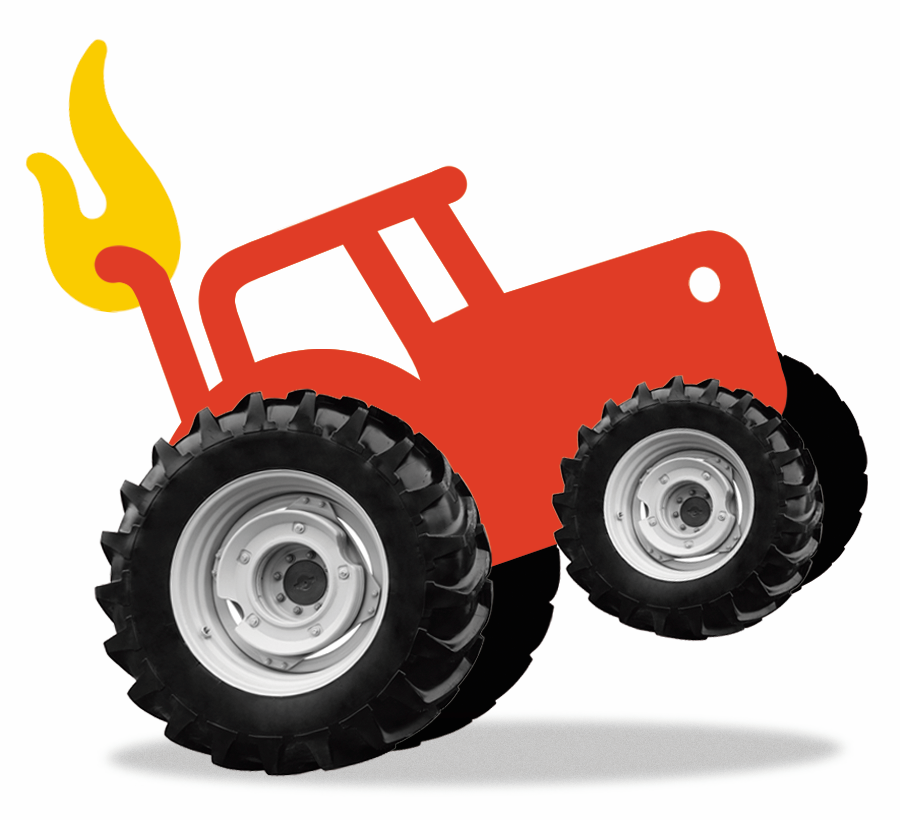How “Conventional” Became a Dirty Word in Agriculture
And why we should instead embrace it
-
-
Share
-
Share via Twitter -
Share via Facebook -
Share via Email
-
Try to imagine what you’d see if you ran a Google Image search for the term “conventional farmer.” I bet you already have a pretty good picture of what the results might look like.
If you do conduct the search, you’ll find pictures of vast uniform rows of green sprouting from the rich dark soil, extending to the horizon. Massive combines harvesting swaths of wheat. Tractors spraying a white mist of fertilizer or pesticide across the fields. Anonymous farmhands, back to camera, bending over the more delicate crops. Notably missing are faces—the “farmers” you were supposed to be looking for.

In contrast, a search for “organic farmer” pulls up scores of smiling people, their arms either laden with a rainbow of crops freshly picked from small farms or wielding handheld farming tools. Not a machine in sight.
Google’s algorithms are smart, and here they’ve tapped into something real about the way the collective conscious imagines and deploys the term “conventional agriculture.” Many writers, activists, and others use it to refer to all forms of agriculture that they consider harmful or otherwise undesirable.
Others use it to describe anything that isn’t organic, regenerative, or following some other type of farming system they wish to see expand. Even researchers, who know to pick their terms carefully, sometimes just use it to mean “control group” when assessing a particular type of farming operation or practice.
But the term “conventional agriculture” reinforces outdated and simplistic views of farming. It wrongly implies that there are widespread farming “conventions” that are static, suggests that less common “alternative” farming practices are universally better, and homogenizes the enormous diversity of farms that exist into a binary.
Consumers, farmers, and policymakers alike would benefit from adopting more colorful language—a richer set of terminology that can capture the wide diversity of farming practices as well as their many tradeoffs.

“Big bad farming”
According to agricultural researchers James Sumberg and Ken Giller, there are three main ways in which the term “conventional agriculture” is commonly deployed.
First, it is used in an analytical context to compare specific farming practices and systems (like organic farming or no-till) with a baseline. Researchers, marketers, and others often highlight the environmental impacts of organic farming by comparing them with those of conventional agriculture. For example, the Forager Project—a plant-based dairy brand—claims that organic food is “better for people” and “better for the planet,” and that “conventional farming is almost solely focused on output, without concern for the long-term impact this approach has on our food quality and security.”
Second, “conventional” is used discursively in advocating for various farming systems that are framed as alternatives to conventional agriculture. In these cases, the term carries a set of implicit associations that help define the alternative in the negative. If conventional agriculture is unsustainable, bad for rural communities, exploitative, or otherwise harmful, then whatever is positioned as its alternative must be the opposite.
Third, the term is often used normatively to promote particular farming approaches. This use explicitly portrays most farms as homogeneous, conservative, old-fashioned, and generally harmful. “Big bad farming,” said one friend, is what the term “conventional agriculture” brings to mind. And that is likely on purpose.
I’d add to Sumberg and Giller a fourth application: to describe what is typical of specific types of farms. For example, in 2021, corn farms in Iowa may have been described as conventionally large—an average of 359 acres. Or, as a recent report on the tractor market claimed, “Conventionally, farmers used diesel engine tractors known for their high power.”
Each of these uses is reductive and can be harmful: there is no single conventional baseline against which to compare new techniques; alternatives always have their own downsides; “Big bad farming” is a myth; and averages obscure vast differences in practice. What’s more, given the specific way in which farming in the United States has evolved, so-called alternative farms often share much in common with the so-called conventional farms they’re poised against. Ultimately, the term conventional agriculture should be abandoned and replaced with words to describe farm characteristics or practices, like no-till, cover crops, or crop rotation, or at least terms like “nonorganic” or nonregenerative when broad-brush generalization is necessary.
ChatGPT HAS ENTERED THE CHAT...
In environmentalist discussions, the term “conventional” often refers to established or widespread practices, technologies, or products that are considered to be typical or standard within a particular industry or sector. The term is often used to distinguish these conventional practices from newer, more innovative or sustainable alternatives that are seen as more environmentally friendly.
For example, an environmentalist might refer to “conventional agriculture” to describe the dominant agricultural practices that are based on large-scale monoculture, the use of synthetic pesticides and fertilizers, and the intensive use of fossil fuels. In contrast, “sustainable agriculture” or “organic agriculture” would be seen as alternative practices that are more environmentally responsible and less harmful to the natural environment.
In the context of energy production, “conventional energy sources” might refer to fossil fuels like coal, oil, and natural gas, while “renewable energy sources” would include wind, solar, and hydropower.
In environmental discussions, the term “conventional” is often used to criticize practices and technologies that are seen as environmentally harmful and to promote alternatives that are more sustainable and environmentally responsible. The use of the term “conventional” highlights the need for change and innovation in established practices, and the importance of moving away from conventional ways of doing things in order to create a more sustainable future.
Conventionally inefficient
What does “conventional” mean? Merriam-Webster says “ordinary or commonplace.” In this sense, conventional farming in the United States, as elsewhere, has shifted dramatically over time. Today, as ChatGPT told me, conventional is “a type of farming that relies on synthetic fertilizers, pesticides, and genetically modified organisms (GMOs) … [and] is characterized by the use of industrial and mechanized methods.” However, in the early 20th century, its meaning was largely the opposite, referring to small-scale farming using traditional hand tools and draft animals—in contrast to the industrialization occurring at that time in other sectors.
In those days, roughly 40% of the labor force worked on farms and 60% lived in rural areas. They were intimately familiar with the daily routines, practices, and requirements of farming. Before 1920, farms were often diversified, growing grains, raising a small number of livestock, and relying on draft mule or horse labor. Many workers used tools that had been in rotation for hundreds or thousands of years. As the historian Deborah Fitzgerald reports in “Every Farm a Factory,” as late as 1937, one researcher wrote that “Moses and Hammurabi would have been at home with the tools and implements of the tenant [cotton] farmer.”
But starting in the 1910s and particularly in the 1920s, agricultural economists, agronomists, and farm educators sought to transform U.S. agriculture. They viewed most farming—or the conventional agriculture at the time—as inefficient and slow to adopt many practices that were increasingly common in other industries. And so, agricultural leaders proposed that farmers take on the trappings of businesses: modern accounting methods, specialized production, and new technologies. For farms, this meant tractors, fertilizer, and more.
As farmers heeded the advice of agricultural educators, they specialized in fewer crops or livestock, expanded the size of their farms (both to achieve economies of scale and maintain their income as margins shrank), and began to rely more on externally produced inputs such as herbicides and scientifically bred seeds. In other words, they industrialized.
What has been typical or common—one definition of conventional—has thus changed dramatically over time. Some practices that were once considered as conventional in the United States, such as relying primarily on manure and compost produced on the farm for fertilizer, went far out of fashion and have now returned as desirable “alternatives” to the status quo.
But such alternatives are not always what they seem. The early- to mid-20th-century industrialization of agriculture gave rise to alternative movements, including movements relating to organic farming. In promoting these alternatives, advocates misleadingly created and reinforced the concept of a homogeneous “conventional agriculture,” while also burying much of the diversity that existed within their own coalitions.
Industrial organic
By the late 20th century, the term “conventional agriculture” was well established as a counterpoint to organic farming, but the story starts much earlier.
The origins of organic farming can be traced back to the early 20th century, when a movement to promote more natural and sustainable methods of agriculture emerged in response to the increasing use of synthetic fertilizers and pesticides. One of the pioneers of this movement was Sir Albert Howard, a British botanist and plant pathologist who is often considered the father of modern organic farming. Howard developed many of the movement’s principles, such as the use of composting, crop rotation, and biological pest control methods, which are still used by organic farmers today.
In the United States, J.I. Rodale, inspired by Howard, founded the Rodale Institute in 1947. He and the institute dedicated themselves to researching and promoting organic farming practices, and they played a key role in popularizing their use in the United States. In the 1960s and 1970s, as more and more of the public—many people motivated by Rachel Carson’s “Silent Spring”—became concerned about the environmental and health impacts of conventional agriculture, the organic farming movement gained further momentum, influencing both farmers and policy.
In 1972, the United States banned the common insecticide DDT, after scientists, “Silent Spring,” and the Environmental Protection Agency concluded it posed a significant threat to the environment, wildlife, and human health. In the 1980s, the U.S. Department of Agriculture began to develop national standards for organic agriculture. Eventually, these were codified, prohibiting the use of most synthetic substances, including synthetic fertilizer and most pesticides, genetically modified seeds, and various other substances and methods.
The period saw a rise not only in organic farming but also in the use of the term “conventional agriculture.” The frequency of its appearance in books, journal articles, and other publications rose dramatically from the 1960s onwards as it was increasingly used to identify farming practices that could be compared with organic ones.
In these days, the term conventional was often used technically to refer to practices or farms that were not organic, but as conventional agriculture came to be associated with a wide range of other characteristics—many of which were viewed negatively—the term took on a new valence. For example, one academic paper in the 1980s defined “ecological” agriculture as self-sustaining, diversified, high-yielding, small-scale, and “aesthetically and ethically acceptable.” It implied that “Western conventional high input agriculture” did not have any of these desirable characteristics.
In fact, it is often assumed that conventional agriculture is large-scale and highly capital-intensive, mirroring the original ideal of American industrialization. In contrast, organic or other types of “ecological” farming are assumed to be small-scale, less commercially oriented and more community-oriented, and otherwise aligned with ideals of an agrarian society.
However, this characterization of organic farming as agrarian and nonorganic (“conventional”) as industrial is quite misleading. As organic farming grew into the $60+ billion industry it is today, once-small organic businesses became major companies or were acquired by big businesses. Many large farms adopted organic practices on at least some of their acreage.
As early as 2001, the journalist Michael Pollan wrote about the rise of “industrial organic” farming. In an article for The New York Times Magazine, he quotes Roger Blobaum—a consumer advocate who pushed for establishing the U.S. Department of Agriculture’s organic program. “Organic is becoming what we hoped it would be an alternative to,” Blobaum had told him. As of 2021, the average certified organic farm operated 224 acres of organic cropland (vs. 445 for all operations). On average, 29% of those farms sell more than $250,000 in organic products, and 41% also produce nonorganic products. The same year, organic farms in the United States also purchased nearly 2 billion dollars’ worth of organic feed for livestock and poultry, and over $500 million dollars’ worth of seeds and seedlings.
In short, many of these organic farms are large-scale operations that purchase massive amounts of external inputs, just as nonorganic farms do.
Compare, don’t scare
Studies have found many substantial differences between organic and nonorganic farms. Organic farms, for example, use less energy, in part because they eschew synthetic fertilizer. And they are more likely than nonorganic farms to plant cover crops, which prevent soil from eroding during the off-season and potentially sequestering carbon in the soil. But organic farms typically also have about 20% lower yields. Thus, most studies find that organic production does not have a lower carbon footprint per unit of output than nonorganic.
Yet these are averages, obscuring how farming practices, environmental impacts, and agronomic performance vary across different types of farms. Taking the headlines from these papers at face value misleads more than it clarifies. Consider the humble apple tree. One study found no statistically significant difference in yields between organic and nonorganic apples. This may be because fruit trees have extensive root systems that can better absorb nutrients when needed compared to annual crops. In contrast, the same study found organic wheat yields are nearly 30% lower than those for nonorganic wheat.
Even crop-specific comparisons should be taken with a grain of salt. Yields, water use, nutrient use, and various environmental impacts can vary widely for one crop based on geography and farm management. In turn, there’s little that a farmer, company, or state policymaker can do based on reports of the average performance of farms across environmental conditions, a country, or even the world. For instance, cover crops may increase soil carbon levels on average, but not in all circumstances, and can be impractical in dryland operations or other water-limited farms. Rather, it’s more important for different stakeholders to understand how various types of farming practices—no-till, cover cropping, using only organic fertilizer, using integrated pest management, etc.—perform in the geography they work within and under relevant management conditions. As discussed in “Measuring What Matters” in a previous issue of this journal, what’s needed is more site- and operation-specific measurement and modeling of the impact of farm management choices.
This illustrates a key principle: comparisons of “conventional,” organic, or any other “alternative” farming system should be as granular and nuanced as possible. Their value lies in identifying the tradeoffs of specific farming practices or sets of practices under different conditions. Organic and other alternative food advocates have fought against what they saw as the standardization and homogenization of farming. Yet their own comparisons, marketing efforts, and educational campaigns reinforce simplified stereotypes of both organic farms and the nonorganic, conventional ones they oppose.
What’s conventional today in U.S. farming?
The term conventional implies that there is a standard or typical way of doing things that can be lumped together and distinguished from an alternative. Conventional vehicles use an internal combustion engine as opposed to electric motors. Conventional energy comes from fossil fuels as opposed to nuclear, wind, hydropower, and solar. Conventional agriculture is often defined as nonorganic (using fertilizer, pesticides, and/or GMOs), large-scale, and reliant on planting monocultures. These are accurate generalizations, but also obscure important trends and types of diversity within farming.
The United States Department of Agriculture (USDA) regularly collects data from farmers that illustrates this. The agency surveys hundreds of thousands of farmers every five years through its Census of Agriculture, in addition to conducting other surveys. This is arguably the most representative and detailed data covering all of U.S. agriculture. The latest Census of Agriculture report, for 2017, spans over 800 pages and provided an excellent picture of agriculture’s
true diversity.
USDA’s data illustrates how farms vary across many more dimensions than how industrial or agrarian they are, or whether or not they’re certified organic. Instead, they vary according to land area, income, source of labor (e.g., family vs. hired), level of mechanization, irrigation use, land tenure, crop type, number of crops, crop rotations, intensity of fertilizer or pesticide use, incorporation of livestock, type of tillage, and whether they plant cover crops, maintain buffer strips, use animal manure, practice various forms of integrated pest management, or use various other management practices.
To be fair, some important notions of what’s typical in farming are spot-on. The 2017 Census of Agriculture notes that most farmland—three-quarters—specializes in grains such as corn and wheat, oilseeds such as soybeans, and cattle or dairy. And these are typically large-scale farms. Farms that planted corn typically did so on 725 acres, and 93% of corn acres planted were biotech varieties. Most commercial farms are also well-capitalized; USDA estimates that corn farms brought in over $300,000 per farm in net income in 2022.
But the data also paints a picture that runs counter to many popular notions. Nearly half of all acres planted with corn are rented. The vast majority of farms—96% in 2017—are family-owned, rather than owned by corporations. Most corn, soy, and wheat farms grow crops in rotation, albeit simple ones, switching crops over time, which can improve soil health and reduce pest pressure. And over 70% of farm acreage is managed with low- or reduced-till methods, which result in less erosion than more intensive tillage approaches.
What is typical or conventional for each farm characteristic also varies both by geography and by commodity. Nearly one out of five farms growing cotton, for instance, now plants cover crops—a much greater proportion than farms growing other cash crops. And many cattle ranches are smaller than is generally assumed; on average, they have 44 beef cows. USDA reports statistics for producers not only of corn, cotton, beef, and other major commodities but also asparagus, partridges, ostriches, and a vast array of other specialty products. Average asparagus production, for instance, shares little in common with that of major cash crops: 75% of farms have less than one acre and it is a perennial crop.
Commercial farms are, after all, businesses. To compete with one another and stay afloat, they have to invest in new equipment and seeds, buy and sell land, engage in new marketing techniques, and otherwise adopt tactics to bring in more money. Owing to the economics of producing different farm products, there are typical characteristics linked to an asparagus, beef, or cattle operation—i.e., practices that farmers conventionally follow. Yet, owing to the particularly strong impact of climate, soil, weather, and other environmental factors in farming, and the people that ultimately lie at the center of each operation—land owners, farm managers, workers—no two farms are ever quite the same.
Even so, as Sumberg and Giller write, the term conventional agriculture has been “weaponized.” To many, it means big and bad and little else. To be clear, there are things that are bad; there are scores of changes that most farmers and farms can make to improve the food system. Incorporate cover crops. Use fertilizer and other inputs more efficiently. The list goes on.
But grouping all types of farms together as “conventional” is an injustice to the great diversity that exists within farming and misleads laypeople into viewing farms as homogeneous while also drawing the focus toward factors such as farm size and whether farms are organic or not, and away from the many other important practices and characteristics that arguably matter more. We need fewer comparisons of conventional and alternative agriculture, fewer generalizations about the average or typical farm, and much more detailed understanding of how specific types of farms with particular management practices operate and compare to one another.

